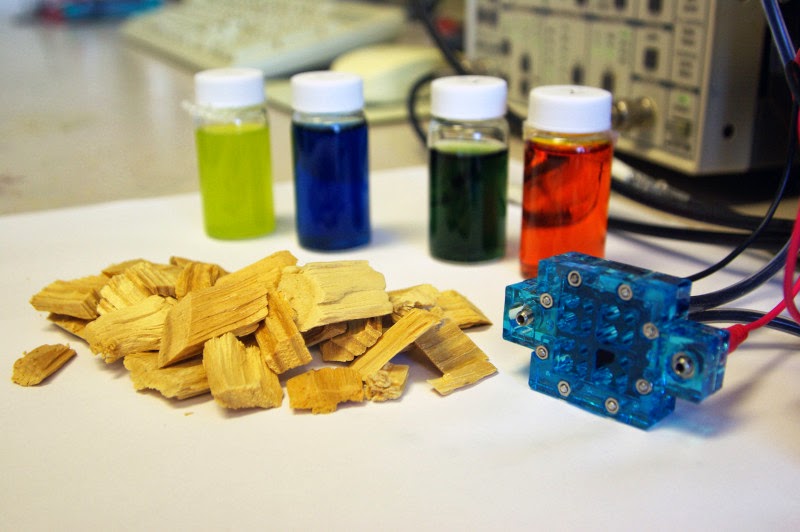Electricity can be produced directly from biomass by Solar-induced hybrid fuel cell
A new solar-induced direct biomass-to-electricity hybrid fuel cell can operate on fuels as varied as powdered wood. The fuel cell
 relies on a polyoxometalate (POM) catalyst (shown in the vials) which changes color as it reacts with light.
relies on a polyoxometalate (POM) catalyst (shown in the vials) which changes color as it reacts with light.
Now, researchers at the Georgia Institute of Technology have developed a new type of low-temperature fuel cell that directly converts biomass to electricity with assistance from a catalyst activated by solar or thermal energy. The hybrid fuel cell can use a wide variety of biomass sources, including starch, cellulose, lignin -- and even switchgrass, powdered wood, algae and waste from poultry processing.
The device could be used in small-scale units to provide electricity for developing nations, as well as for larger facilities to provide power where significant quantities of biomass are available.
The challenge for biomass fuel cells is that the carbon-carbon bonds of the biomass -- a natural polymer -- cannot be easily broken down by conventional catalysts, including expensive precious metals, Deng noted. To overcome that challenge, scientists have developed microbial fuel cells in which microbes or enzymes break down the biomass. But that process has many drawbacks: power output from such cells is limited, microbes or enzymes can only selectively break down certain types of biomass, and the microbial system can be deactivated by many factors.
The system provides major advantages, including combining the photochemical and solar-thermal biomass degradation in a single chemical process, leading to high solar conversion and effective biomass degradation. It also does not use expensive noble metals as anode catalysts because the fuel oxidation reactions are catalyzed by the POM in solution. Finally, because the POM is chemically stable, the hybrid fuel cell can use unpurified polymeric biomass without concern for poisoning noble metal anodes.
The system can use soluble biomass, or organic materials suspended in a liquid. In experiments, the fuel cell operated for as long as 20 hours, indicating that the POM catalyst can be re-used without further treatment.
Source : Science daily

Now, researchers at the Georgia Institute of Technology have developed a new type of low-temperature fuel cell that directly converts biomass to electricity with assistance from a catalyst activated by solar or thermal energy. The hybrid fuel cell can use a wide variety of biomass sources, including starch, cellulose, lignin -- and even switchgrass, powdered wood, algae and waste from poultry processing.
The device could be used in small-scale units to provide electricity for developing nations, as well as for larger facilities to provide power where significant quantities of biomass are available.
The challenge for biomass fuel cells is that the carbon-carbon bonds of the biomass -- a natural polymer -- cannot be easily broken down by conventional catalysts, including expensive precious metals, Deng noted. To overcome that challenge, scientists have developed microbial fuel cells in which microbes or enzymes break down the biomass. But that process has many drawbacks: power output from such cells is limited, microbes or enzymes can only selectively break down certain types of biomass, and the microbial system can be deactivated by many factors.
The system provides major advantages, including combining the photochemical and solar-thermal biomass degradation in a single chemical process, leading to high solar conversion and effective biomass degradation. It also does not use expensive noble metals as anode catalysts because the fuel oxidation reactions are catalyzed by the POM in solution. Finally, because the POM is chemically stable, the hybrid fuel cell can use unpurified polymeric biomass without concern for poisoning noble metal anodes.
The system can use soluble biomass, or organic materials suspended in a liquid. In experiments, the fuel cell operated for as long as 20 hours, indicating that the POM catalyst can be re-used without further treatment.
Source : Science daily
- Landfill Gas Power Plants And Biomass
Landfill gas power basically refers to the two greenhouse gases of carbon dioxide and methane. It is therefore a form of biomass used in the generation of energy whereby biomass refers to the microorganisms found in organic materials from animals and...
- Green Furnace
What is Green Furnace? The furnace which uses renewable sources like natural fuel for their operation is called green furnace. Typically, a green furnace uses olive pits, nut shells, wood, wood pellets from forest residues or surplus industries etc. Green...
- Biofuels
What are Biofuels? Biofuels are fuel having energy from geologically recent carbon fixation which are produced from living organisms. Carbon fixation exists in plants and micro algae. These fuels are produced from a biomass conversion. There are...
- Green Energy
What is Green Energy? Green Energy is the energy which is produced from natural resources like sunlight, wind, tidal wave and geothermal heat. It is also called renewable energy or alternative energy and sustainable energy. Green Energy...
- Types Of Biomass
Scientists recognize four types of biomass:Wood and agricultural products: This consists of so-called ‘home-grown' products such as wood logs and chips etc. It is important to note that almost any biological matter can produce biomass energy. Agricultural...
